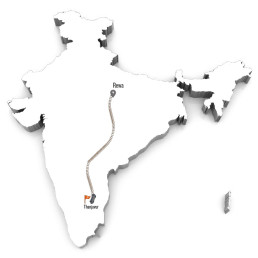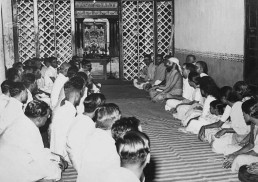
Jnana Yajna 20

Year & Dates:
July 14, 1956 to August 04, 1956

Yajna Topic:
Ishavasya Upanishad

Place:
Thanjavur (Tanjore), India.
Thanjavur’s historic Saraswati Mahal Library, Tamil Nadu, is an acclaimed place of learning and cultural preservation. Its rare palmyra manuscripts, famed collection of medieval books in several indigenous languages, and museum of intricate paintings makes it one of the outstanding libraries in Asia. In such an appropriately eminent place of knowledge, the Upanishad Jnana Yajna of Pujya Gurudev commenced on the sacred Guru Poornima day of July 14, 1956. During that period, the state was gripped by the tension between the orthodox ritualists and the Dravida Kazhagam members who were iconoclasts opposed to Sanatana Dharma. Fearless and fair as Pujya Gurudev was, He welcomed the questioning tendency of the opponents and encouraged the ritualists to strengthen their scriptural knowledge beyond mere practices.
Fearless Power of Satsang
His rational and clear explanations of the declarations of Ishavasya Upanishad every evening for 21 days caught the attention of both these opposing factions and converted many of the skeptics. Pujya Gurudev enthralled the listeners especially with His out-of-the-world meditation sessions every night, during the last half hour of each session. While the supplemental Sadhana such as Akhanda Keertana and the Havana energized the seekers, there were obstacles that arose. Especially on the first three days of August, the Dravida Kazhagam had announced about breaking Sri Rama’s pictures which prompted a statewide curfew. However, Pujya Gurudev’s Upanishad yajna proceeded unhindered. Later, during the procession after their sacred bath, when loud slogans disrupted their keertana, the devotees persisted with their singing to overcome the disturbance. The ardent seekers could stand strong not with negativity but with the firm conviction about the greater goal of life.
In Admiration
Shri Yagnaswami from Tanjore reflects on the insights acquired through the teachings of Gurudev. “I learnt that Bhakti, Jnana and Karma are not distinct limbs of separate Yogas. Bhakti, pure and simple, is the outcome of Jnana. In the first the heart comes into play, in the second Intellect or Jnana enlightens it; the combination of these two is Supreme Love or Prem. My Grhasthaashrama experiences, with all its complications do not now affect me: I remain unattached. Even under extreme provocation, I remain calm and unperturbed due to Guru-Krpa.
Photo Gallery

“Think,” Says Pujya Gurudev
Devotion to a personal God with a form and name is as much important for higher meditation, since continuous and intense meditation upon the formless Reality is necessary for the greater realization of the Self. In this intelligent synthesis of Bhakti and Jnana together the result would be, in the Rishi’s own words, that we will be able to get over the sorrow of death, meaning the sorrows of finitude, because of our faith and devotion to the Lord with a form, while our evolution would be fulfilled completely as a result of our higher meditations upon the formless Reality. A mere meditation upon the Absolute in itself, though it can give a subjective experience of the Self, the Jeevan-Mukta state cannot be peaceful and tranquil without the firm hold on the life-belt of a staunch and unshakable prema for the Lord of the heart.
From Ishavasya Upanishad Book
Which Path Do You Choose?
Embark on a soul-searching journey as Swamiji delves into life’s pivotal question: which path will you choose? Dive into the exploration of contemplation, meditation, or the selfless path of action (Karma Yoga). Gain profound insights into the significance of each choice and the impact it can have on your life’s purpose. Join us in this enlightening discussion and discover the transformative power of your chosen path.


